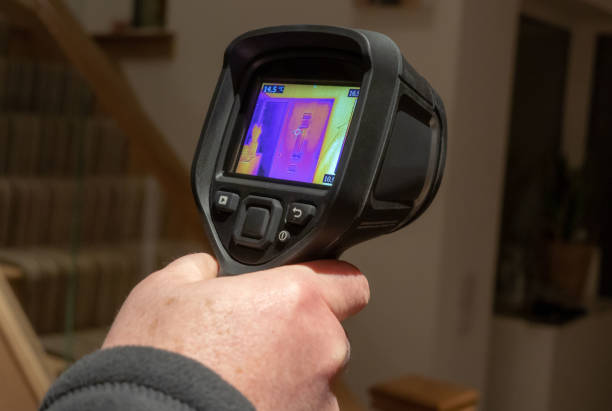It is helpful to look for a few essential features to help you choose the best camera for your needs. These include thermal sensitivity, resolution, and emissivity. Thermal images overlaid on a visual image can help you identify studs in walls, plastic pipes, and furniture in a dark room. In addition, thermal images are commonly used by firefighters to understand their surroundings better.
Self-referencing within 250 ms
Self-referencing algorithms can be used to automatically measure temperature variations without the use of an external reference. Such algorithms can be implemented in software, firmware, or associated hardware circuitry and can automate a wide range of infrared thermography applications. They can also be applied to static infrared thermographic hot spot detection and dynamic infrared tomography applications.
Various embodiments of the present invention include a self-referencing algorithm, which boosts the intensity of pixels exceeding a threshold temperature. These algorithms can also be used to determine the change in temperature over time. Self-referencing algorithms are generally based on the signal-to-noise ratio of a thermal profile.
Self-referencing within 250 ms allows for accurate temperature measurements. The software will choose the best correction method based on the temperature difference. Significant temperature differences are best corrected using the offset method, while slight differences can be corrected with gain. Both methods require the reference temperature value or measurement area to reach the target temperature value.
Thermal sensitivity
A thermal camera is a camera with a thermal imaging sensor. The camera outputs a thermal image in a binary format containing the brightest parts (white), intermediate temperatures (red and yellow), and dim parts (black). Unlike optical cameras, thermal cameras have a lower resolution than those optical cameras. A typical thermal camera has a 160 x 120 pixels resolution, while a high-end model can achieve 1280 x 1024 pixels. These cameras are expensive compared to cameras with visible spectrum resolution. Even low-end models can cost hundreds of dollars.
Infrared cameras with extended temperature ranges have several advantages. One is that they can capture infrared images in harsh environments. The cameras are generally heavier and more prominent, and the cooling process can be costly. The cameras also require more power and are time-consuming.
Thermal sensitivity is one of the most important specifications when choosing a thermal camera. It is also known as NETD and describes how much of a difference a thermal camera can detect. Lower numbers mean the camera is more sensitive, while higher numbers mean the temperature difference is less.
Detector resolution
Detector resolution measures how sensitive the infrared camera is to temperature variations. The smaller the resolution, the more apparent the temperature variations. The camera aims to detect temperature fault points and relative hot spots. So, the higher the temperature resolution, the better.
The size of the pixels on the detector is related to the resolution. For example, a 320×240 pixel camera has a pixel resolution of 76800. A 160×120 pixel camera produces an image that is only a fourth of the size of the full-resolution 320×240 detector.
Detector resolution of an infrared camera with an extended temperature range should be a consideration for users when deciding which thermal imaging camera to buy. The higher resolution, the better, but it is important to note that the price is also related to the resolution. For example, high-resolution thermal cameras may cost $30,000, while low-resolution models can cost less than $1,000. Despite their price, many users wonder if higher resolution is worth the extra money.
Thermal cameras use Indium Gallium Arsenide (InGaAs) as their detector. This type of detector is available in thermoelectric, cryogenic, and non-cooled versions. Their sensitivity range is 0.9 to 1.7um. They are useful for applications in spectral imaging, agriculture, and high-temperature furnace monitoring.
Detector emissivity
The emissivity of an infrared camera detector is critical because it affects the accuracy of temperature measurements. For example, if a temperature is too low or too high for a particular object, the camera’s temperature measurement will be inaccurate. In addition, low emissivity can cause a false impression of the object’s temperature and cause an infrared image to be distorted.
The emissivity of an infrared camera’s detector depends on the wavelengths the instrument identifies. Infrared radiation consists of two types of energy: heat and visible light. Each of these energies treats different objects differently. An infrared camera’s eyes are designed to detect these different wavelengths.
Unlike a conventional infrared camera, the detector emissivity of an infrared camera with an extended temperature range is a more important consideration than its display resolution. You may check Termocamera FLIR E8 to learn more about this!
The emissivity of an infrared camera with an extended temperature range is a measure of its sensitivity. It is the difference between the minimum temperature of an object at two points on the image. When an object is solid, its emissivity is constant, whereas it is variable for liquids and gasses.
Detector emissivity of an extended temperature range should be close to the target’s emissivity. The target temperature will have less impact from atmospheric radiation. However, in close ranges, the atmosphere and reflections will affect the target temperature more.


Leave a Reply